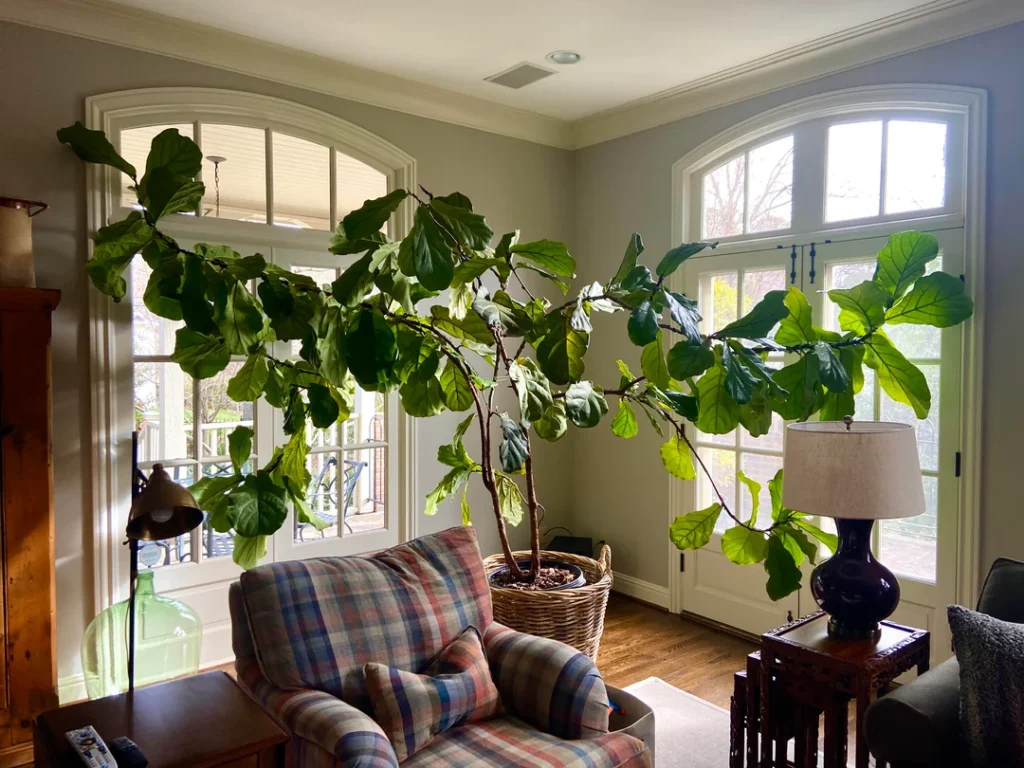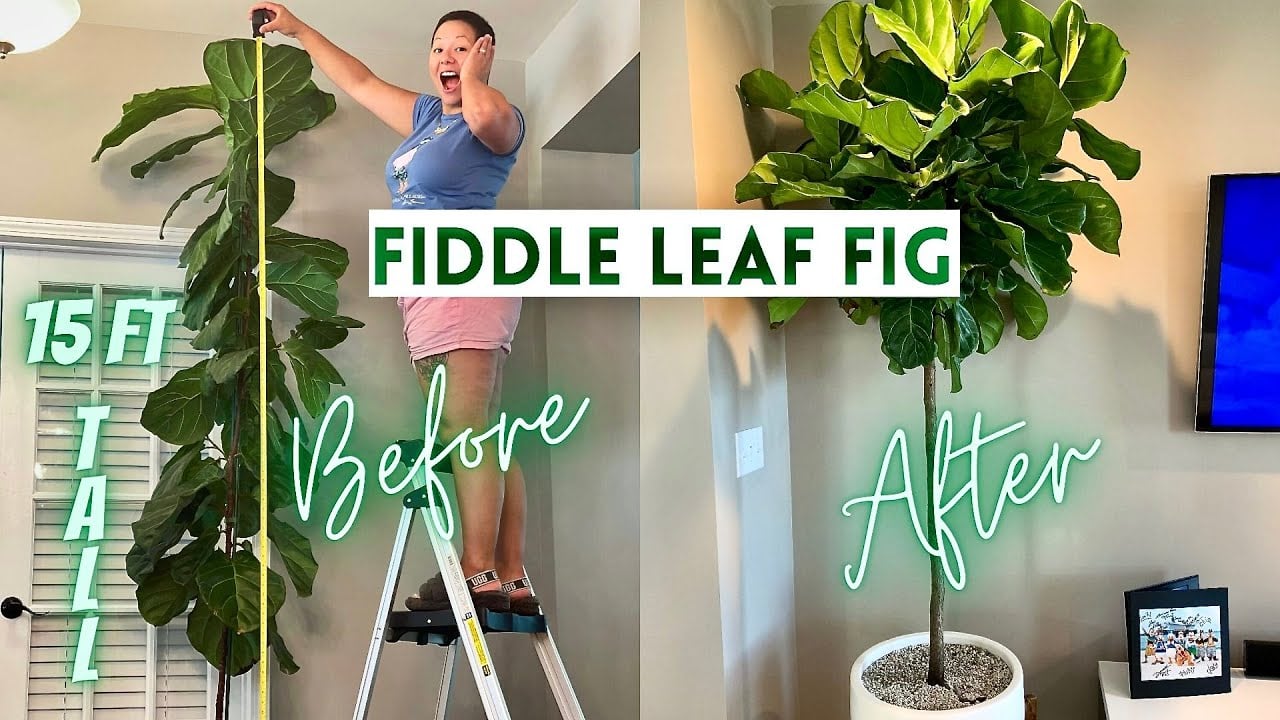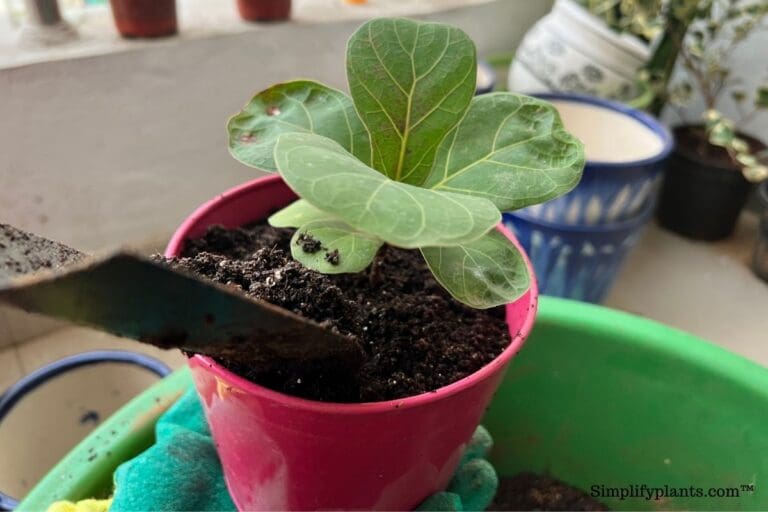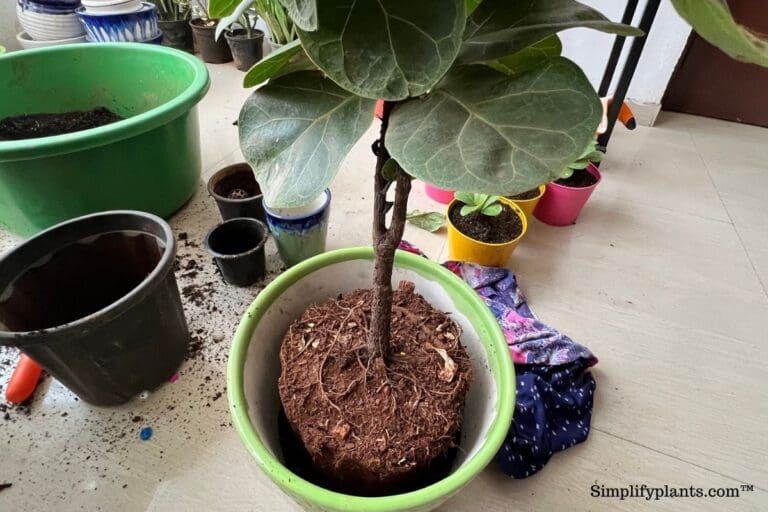What to Do When Your Fiddle Leaf Fig Gets Too Tall?
Fiddle leaf figs add a touch of greenery to any room, but what do you do when they get too tall?
Trim your fiddle leaf fig to maintain its shape and size.
This keeps it looking great and helps it grow healthier. 🌿
Ever tried to move a tall plant around the house? It’s a struggle!
By keeping your fiddle leaf fig at a manageable height, you avoid those awkward moments. Plus, you can easily place it in your favorite sunny spot. 🌞
Have you ever noticed your fiddle leaf fig looking a bit wobbly?
When it gets too tall, the stem might not support the weight well.
Pruning helps strengthen your plant, so it stands tall and proud without tipping over.
Have you had this issue with your plant? Share your experiences in the comments! 🌱💬

Please note: Simplify Plants is reader-supported. As an Amazon Associate, I earn from qualifying purchases made by our readers with no extra cost added to you all! Some links in the post are affiliate links and I get a commission from purchases made through links in the post.
Understanding Your Fiddle Leaf Fig’s Growth
When your fiddle leaf fig gets too tall, it’s important to know why it’s growing so much and what it needs. Let’s look at its growing conditions and patterns.
Optimal Growing Conditions
Fiddle leaf figs love bright, indirect light. They can tolerate some direct sun, but too much can scorch their leaves. Is your fig near a big window? It might be asking for a sun tan!
Keep the room temperature between 60°F to 75°F. ❄️ Too cold or too hot, and your plant might not be happy.
They also enjoy a little extra humidity. Try misting its leaves or using a humidifier to keep it smiling.
Water your fig when the top inch of soil is dry. Over-watering can lead to root rot.
I check mine weekly. Do you? Too little water, and you’ll notice dry, brown edges.
Common Growth Patterns
Fiddle leaf figs tend to grow upright and can reach impressive heights! 📏 If your fig is getting too tall, it’s not unusual. They can grow up to 10 feet indoors!
You might notice that your fig grows faster in the spring and summer. This is its active growth period. In the fall and winter, it might slow down, and that’s totally normal.
Are the leaves at the top bigger? This happens because the plant is reaching for light. Sometimes, you might notice new branches – that’s the fig’s way of spreading out.
If your fig is towering, it might be time to trim it back!
Got a quirky fig? Share your stories in the comments! 🌿
Preventive Measures for Height Control
By controlling the height of your fiddle leaf fig, you can keep it healthy and looking great. Here are some useful techniques you can use to manage its growth.
Pruning Techniques
Pruning is like giving your fiddle leaf fig a haircut! ✂️
Remove the top leaves to stop it from growing too tall. Use clean, sharp scissors to cut just above a leaf node. This encourages the plant to grow outwards instead of upwards.
Another method is pinching, where you gently snap off the new growth with your fingers. It’s easy and effective!
Be careful not to overdo it; prune little by little.
Have you ever tried pruning your plants? 🌿 If not, give it a go and see the difference!
Pot Size and Growth Limitation
Did you know the size of the pot can control how big your fiddle leaf fig gets?
If you keep it in a smaller pot, it won’t have as much room to grow tall. This is a clever trick to manage its height!
Larger pots give the roots more space, leading to a taller plant. 🪴
If your fig is getting too tall, consider repotting it into a smaller container.
How do you feel about changing your plant’s pot?
Remember to gently loosen the roots before repotting to avoid shocking the plant.
What techniques do you use to keep your plants in check? Share your tips below! 📸✨
When to Consider Repotting

If your fiddle leaf fig plant is getting too tall, you might need to repot it. This can help the plant stay healthy and grow better.
Signs of Root Crowding
One big sign that your fig might need repotting is root crowding.
If you see roots poking out from the bottom of the pot or circling around the pot’s edge, it’s time to act.
Sometimes, the soil might dry out very quickly because the roots have taken up all the space.
Does your plant tip over easily? That’s another hint the roots are too crowded in their current pot.
Don’t wait too long to repot. Root-related problems can cause poor growth and yellow leaves.
Choosing the Right Pot
Picking the right pot is crucial. It should be about 2 to 4 inches wider in diameter than the current one.
Make sure it has drainage holes at the bottom to prevent water from sitting in the soil.
A slightly larger pot gives the roots enough room to spread out without being too roomy. Too big a pot can actually cause root rot because of excess moisture.
Have you ever tried lifting a big, heavy plant? It’s no joke!
Choose a pot you can move around easily. Also, consider the pot’s material; plastic pots are lighter, clay pots are sturdier.
Repotting can rejuvenate your plant 🚀. Have you experienced this with your fiddle leaf fig? Share your thoughts below!
Practical Pruning Steps
When our fiddle leaf fig gets too tall, it’s pruning time! I’ll guide you through the preparation and exactly how to make the perfect cut.
Preparation for Pruning
Before you begin pruning, gather necessary tools: sharp pruning shears, rubbing alcohol, and a tarp to catch leaves.
Ensure your shears are disinfected to avoid spreading diseases to your plant.
Clean shears make cleaner cuts, which helps the plant heal faster. 🌿
Next, identify the branches you need to cut. Look for overly tall or leggy sections that disrupt the plant’s shape.
Create a pruning plan by visualizing which parts of the plant need trimming to maintain a balanced look.
Don’t be afraid to take your time to decide what’s best for your plant.
Do you see any damaged or dead leaves? Remove them first to keep your fig healthy.
When you’re ready, wear gloves to protect your hands and lay down the tarp to minimize clean-up afterward.
Preparing well ensures a smooth pruning process.
Have you ever had to prune a plant before? Share your experience!
How to Make the Cut
When it comes to actually cutting, always cut above a node or leaf, as this is where new growth will appear.
If you cut between nodes, you’ll end up with a stub that won’t produce new leaves.
Hold the shears at a 45-degree angle and make a single, clean cut. Avoid jagged cuts as they can slow down the healing process.
If the branch is thick, a saw might be more effective. Start with smaller branches until you get the hang of it.
Make sure to step back periodically and check how the plant looks. This helps in making sure the plant maintains a good shape.
Remember, a balanced approach works best. Pruning shouldn’t be stressful—it’s like giving your plant a stylish haircut. ✂️
Have you found a technique that works well for you? Drop a tip in the comments!
Caring for Your Fiddle Leaf Fig Post-Pruning

Once you’ve pruned your fiddle leaf fig, it’s crucial to take care of the plant for it to thrive and grow back stronger.
Post-Pruning Care
After pruning, I always make sure to water my plant gently. The soil should be moist but not soggy. Too much water can cause root rot.
I also check the humidity. Fiddle leaf figs love humidity, so I mist the leaves or use a humidifier.
Another key step is to fertilize the plant. Use a balanced fertilizer once a month to provide essential nutrients. It helps the plant recover faster and promotes new growth.
Don’t forget to clean the leaves. Dust can block sunlight and affect photosynthesis. I use a damp cloth to wipe the leaves gently.
Light is vital. Place your plant in a spot where it gets bright, indirect sunlight. Too much direct sunlight can burn the leaves, while too little can slow down regrowth.
Monitoring Regrowth
After a few weeks, I start to watch for new growth. Look for new leaves or stems emerging.
It’s a sign your plant is healthy and recovering well.
If growth seems slow, don’t worry. Fiddle leaf figs can take some time to bounce back. Just ensure it gets the right care.
I also rotate the plant every few days. This helps ensure even growth and prevents the plant from leaning towards the light source.
Have you noticed any changes in your fiddle leaf fig post-pruning? Do you have any tips that have worked for you? Share your thoughts in the comments below! 🌿✨
Propagation from Cuttings

Growing new fiddle leaf fig plants from cuttings is a great way to manage their height and create more plants for your home. Learn how to propagate new plants and the best rooting techniques to be successful.
Propagating New Plants
I love turning tall fiddle leaf figs into more beautiful plants. Anyone else excited about it?
First, you’ll need a healthy cutting with at least one leaf and a small section of stem.
Cut the stem right below a node (a spot where leaves grow), as this is where new roots form.
It’s like giving your plant a chance to start fresh! 🌱
Next, let the cutting sit out for a day or two until the cut end dries up and calluses over. This prevents rot when you put it in water or soil.
What’s your favorite propagation hack? Share below! 😊
Rooting Techniques
Now, let’s get those cuttings to root! There are two main methods: water rooting and soil rooting.
Water rooting is simple. Place your cutting in a jar filled with water, making sure the node is submerged.
Change the water every week to keep it fresh and clean. 🌊
For soil rooting, plant the cutting in a pot with well-draining soil.
Water well and keep it in a warm, bright spot, but out of direct sunlight.
I find this method reliable because the cutting gets used to the soil right from the start.
Which method have you tried? Drop a comment and let’s chat! 🌿✨
Long-Term Maintenance Strategies

Here are some key tips to keep your fiddle leaf fig healthy and prevent it from becoming too tall. Consistent care and proper pruning are crucial.
Routine Care Schedule
I find that setting a routine care schedule is essential.
Start by watering your fig once a week, making sure the soil is moist but not too soggy.
Check the soil with your finger; it should feel slightly damp about an inch down.
Make sure to dust the leaves regularly. Dust can block sunlight and affect growth.
Use a damp cloth and gently wipe the leaves clean.
Don’t forget to rotate the plant every two weeks for even light distribution.
Fertilize your fig every month with a balanced, water-soluble fertilizer. Always follow the instructions on the package.
Light pruning during the growing season (spring and summer) helps maintain its shape and size.
Do you have any unique care routines for your fiddle leaf fig? 🌿 Share in the comments!
Height Management Over Time
Managing the height of a fiddle leaf fig can be tricky, but it’s doable!
Prune the top of the plant during the growing season to keep it at a manageable height.
Use clean, sharp pruning shears and make cuts just above a node (where a leaf attaches to the stem).
Sometimes, the plant may grow sideways.
In these cases, use stakes and ties to guide the stems upward.
You can also try air layering to propagate new plants from taller stems.
This involves creating a small wound in the stem, wrapping it with damp moss, and covering it with plastic until roots form.
Feeling adventurous? 🌿
Why not try propagating your fig and growing a new one? Let me know how it goes in the comments!
Creative Solutions for Excess Height
When your fiddle leaf fig gets too tall, you can try some creative ways to manage its height and still enjoy its beauty.
I’ll share tips on styling and shaping and how to support tall branches.

Styling and Shaping Ideas
One way to deal with a tall fiddle leaf fig is trimming the top leaves. This will make the plant look fuller and encourage lower leaves to grow.
You can also train the plant to grow a unique shape. When I bend and tie the branches, I create a cool zigzag pattern or arch.
Ever tried bonsai techniques? They can keep your fig small and stylish.
Please note, always use clean, sharp scissors when trimming to avoid damaging the plant.
Adding short 3D objects around the base can make the tall fig look artsy.
Statues, stones, or even fairy lights give a fresh look without reducing the height.
Tall plants can sometimes look messy.
If your space permits, a large decorative pot can balance the height and add style.
Supporting Tall Branches
When my fiddle leaf fig reaches impressive heights, I find it essential to support the tall branches. Otherwise, they can lean or even break.
I use stakes or bamboo canes, which are both sturdy and easy to find.
Tie the branches loosely with soft ties to avoid cutting into the bark.
Another idea is plant stakes that blend with the decor.
I’ve seen friends use stakes with cool designs that look like part of the plant’s setup.
Sleek stakes keep branches upright without stealing the spotlight.
If my plant is top-heavy, I sometimes prune a few branches. This makes the plant more compact and healthy.
Be careful not to over-prune, though! My fig always looks best when it’s balanced.
Got any tricks for tall fiddle leaf figs? Drop them in the comments below! 🌿🌱✨
Troubleshooting Common Height Issues

I’ve had my share of fiddle leaf figs growing too tall, too fast. It can definitely be a challenge! Here are some problems you might face and how to fix them:
1. Weak Stem 💪
If your fig is growing tall but has a weak stem, it might tip over. This happens, right?
To fix this, gently shake the stem every day. It sounds funny, but it helps strengthen the stem.
2. Root Bound 🌿
A root-bound plant won’t grow properly. If your fig’s roots are circling the pot, it might be time to re-pot.
Choose a pot just a bit larger than the current one. This gives the roots space to grow.
3. Lack of Light 🌞
Is your fig not getting enough light? This makes it grow tall and leggy.
Make sure your plant gets bright, indirect light. Move it closer to a window if needed.
4. Overgrowth ✂️
If your fig is just too tall, you can prune it. Trim the top to make the plant shorter.
Don’t forget to use clean scissors. I’ve done this, and it really helps keep the plant manageable.
5. Uneven Growth 📏
Sometimes, our figs grow taller on one side.
Rotate your plant every few weeks so all sides get equal light. It helps balance the height.
Have you faced any of these issues with your fiddle leaf fig? Share your experiences or tips in the comments! 🌿✨
FAQs

Q: How tall is too tall for a fiddle leaf fig?
A: If your fiddle leaf fig is hitting the ceiling or cramming your space, it might be too tall. Most indoor spaces can handle a height of 6-10 feet. 🌿
Q: Can I trim my fiddle leaf fig to make it shorter?
A: Yes, you can trim it! Use sharp, clean tools to cut back branches. Don’t be afraid; trimming can promote healthier growth.
Q: Where should I make the cuts?
A: Cut just above a leaf node, where new leaves sprout. This encourages branching and a fuller plant. ✂️
Q: What do I do with the cuttings?
A: Propagate them! Place the cuttings in water until roots form, then pot them in soil. Free new plants, anyone? 🌱
Q: Is there a best time of year to trim?
A: Trimming in spring or early summer is ideal when the plant is actively growing. Avoid trimming in winter to prevent shock.
Q: Will my plant be okay after trimming?
A: Yes, your fiddle leaf fig should thrive with proper care.
Keep an eye on its water and light needs, and it’ll bounce back.
Q: Can I prevent it from getting too tall?
A: Regular pruning helps control height. Providing sufficient light can also mean less leggy growth.
Q: How do I share my experience with others?
A: I’d love to hear from you! Share your tips or ask more questions in the comments below.
Let’s help each other keep our fiddle leaf figs happy and thriving! 🌿✨
Got other questions? Drop them below! 😊
Conclusion
Keeping your fiddle leaf fig at a manageable height can be a fun task.
I love seeing how these plants respond to a bit of TLC.
Have you ever tried trimming yours? Share your experiences below! 🌿
Remember, you can always propagate the cuttings to create new plants. How cool is that?
Double the figs, double the fun! 🌱
If you find it challenging, don’t worry, that’s part of the plant parenthood adventure.
Trust me, I’ve been there!
Got any tips or tricks? Drop them in the comments.
Let’s help each other out! 💬
Feel free to show off your trimmed fig trees with a photo—I can’t wait to see them! 📸
Note: Some images in the articles are sourced from Reddit and Other Platforms For Reference Purpose.







